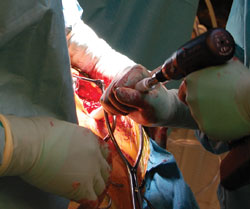Similar short-term results for uncemented large diameter head and cemented THA
Short-term results of cementless large diameter head total hip arthroplasty were comparable to cemented total hip arthroplasty, according to Finnish researchers who studied the outcomes in a nationwide database.
Jari Mokka, MD, of Turku, Finland, is scheduled to present the findings at the 13th EFORT Congress 2012.
“We have a long history with cementless hips as our workhorse,” Mokka told Orthopaedics Today Europe. “As the [large diameter heads (LDH)] were developed, we adopted [metal-on-metal (MoM)] combined with LDH with cementless stems as our primary device for the active patient. We have had very good results with our implant, but we knew that some of the devices had poor results … we wanted to check the nationwide results of all MoM devices.”

This intraoperative image shows reaming the acetabulum for a monoblock MoM acetabular component.
Images: Mokka J
Mokka’s team used data from the Finnish Arthroplasty Register to study the revision risk of 8,059 cementless LDH MoM total hip arthroplasties (THAs) performed from 2002 to 2009 and compared it to the revision risk of 16,978 cemented metal-on-polyethylene THAs done in the same period, according to the abstract. They found no difference in revision risk between the two types of THA procedures, with both having a 0.9 relative risk of revision.
However, in women aged 55 years or older, uncemented LDH MoM THA demonstrated a significantly increased revision risk vs. cemented THA, Mokka and colleagues stated in the abstract. There were likely several factors that contributed to this finding: bone quality and a slightly greater tendency for younger women to have dysplastic hips, Mokka noted.
“Often, women’s hips are more lax than [men’s], so telescoping of the THA is probably more likely to happen and more metal debris will be produced,” Mokka said. “Women also [receive] smaller cups, so head diameter is smaller and point forces are higher. Thus, achieving correct cup inclination and anteversion is even more difficult. There is more stem subsiding and acetabular component loosening in females.”
While women aged 55 years or older should be watched for inferior results following cementless LDH MoM THA, Mokka and colleagues said survivorship of cementless LDH MoM THA was comparable to cemented THA at the nationwide level. Implant design, however, impacted revision rates.
“Not all MoM LDH designs are equal,” Mokka said. “Some of the designs do as well [as] or better than conventional THAs. All MoM LDH designs are very sensitive to component positioning. Conventional THAs are more forgiving in that sense. We should not abandon the whole concept, but we definitely need longer follow-up to be sure.” – by Robert Press
Reference:For more information:
- Mokka J, Makela K, Virolainen P, et al. Cementless total hip arthroplasty with large diameter metal-on-metal heads — short term survivorship of 8,059 hips from the Finnish Arthroplasty Register. Scheduled to be presented May 23, 16:45-17:45, at the 13th EFORT Congress 2012. May 23-25. Berlin.
- Jari Mokka, MD, can be reached at jari.e.mokka@pp.fimnet.fi.
- Disclosure: Mokka has no relevant financial disclosures.
